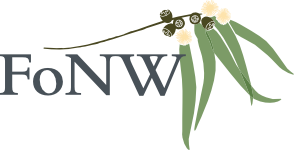A recent article caught my attention in the Australasian Bat Society (ABS) Newsletter, Number 43, Late 2014 by Robert Bender, Stephen Griffiths and Lindy Lumsden titled Bats breeding in Melbourne roost boxes. The Batting4Bayside project in Bayside is busy making bat boxes and planning to monitor them as our local residents put the bat boxes up in their own gardens. The three species mentioned in the article have all been identified from Bayside too. I thought you might be interested to know what has been happening over the last 20 years at the prime Melbourne study sites of Organ Pipes National Park and Wilson Park, East Ivanhoe.
At the Organ Pipes National Park bats were found in several boxes in late 1994. During those early years only Gould’s Wattled Bats (Chalinolobus gouldii) were found breeding in the boxes. Large Forest Bats (Vespadelus darlingtoni) began using the boxes as breeding sites in the late 1990’s, although less regularly. After 6 years the first White-striped Free-tailed Bat (Austronomus australis) first appeared and varied in numbers over the next decade. Large numbers were found in October and December, peaking in April after the end of the breeding season. It is interesting that in one box were mixed pregnant, lactating and nonbreeding plus 2 adult male White-striped Free-tailed bats, plus one adult male Gould’s Wattled Bat.
The much later commencement of the Wilson Reserve Bat Box Project on the north side of the Yarra in February 2005 showed similar species variation to the first site. Following Gould’s Wattled Bat were Eastern Broadnosed Bats (Scotorepens orion) generally found in ones and twos, peaking in February with smaller numbers in early spring and early summer.
I find it fascinating that microbats are gregarious enough to mix so closely with another species as described at Organ Pipes N.P.
To date the above study group, which set up another colony approximately a kilometre away from the Wilson Reserve, had found only one instance of movement between such colonies. The suggestion is a possible migrant dispersing from its birth colony elsewhere may have moved between the two colonies.
Friends of Native Wildlife Inc. have bat boxes available (contact at info@bayfonw.org.au). You are welcome to join a working bee to support making and/or monitoring the boxes with our endoscope provided by the Norman Wettenhall Foundation.
Elizabeth Walsh



